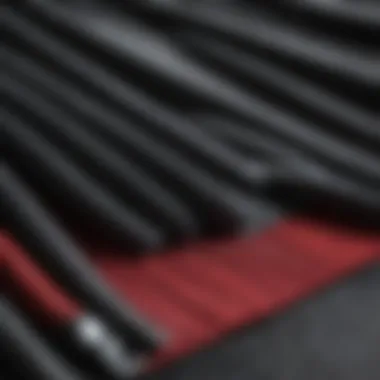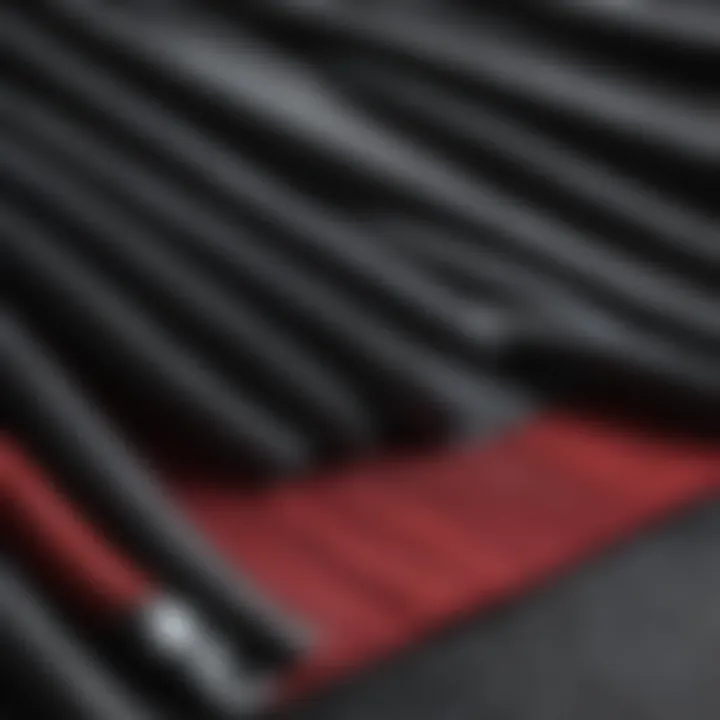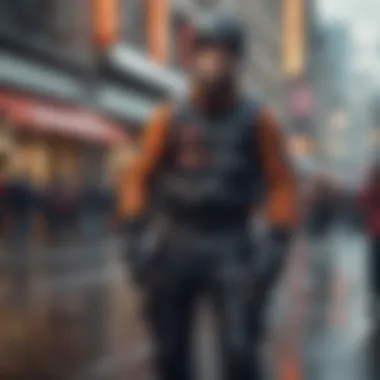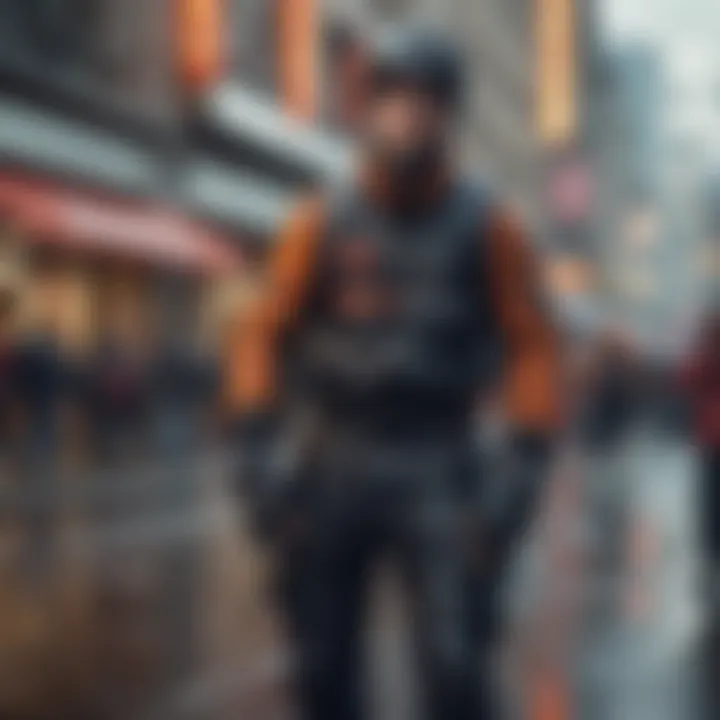Street Made Clothing: Style Meets Function in Extreme Sports


Intro
Street made clothing occupies a unique niche at the crossroads of style and functionality, particularly within the extreme sports sector. The aesthetics of this clothing are not merely for show; they serve significant practical purposes for athletes engaged in activities like skateboarding, snowboarding, and BMX riding. The fusion of street fashion into this realm provides a cultural backdrop while enhancing performance and comfort for those who live for adrenaline.
The rise of street made clothing reflects a broader trend where style is increasingly seen as part of a sport's identity. Athletes are not just participants in their respective sports but also representatives of a lifestyle that values both appearance and utility. This article delves into various aspects, including the materials commonly used, the evolution of design trends, and the ways in which brand identities have shaped this clothing style. Ultimately, we aim to highlight the relevance of street made clothing in enhancing both the performance and lifestyle of extreme sports enthusiasts.
Techniques and Tips
Skill Development
Skill development in extreme sports goes hand in hand with the proper attire. Wearing the right street made clothing can greatly influence an athlete’s ability to execute maneuvers safely and efficiently. For instance, breathable fabrics allow for greater mobility while also helping regulate body temperature during intense activities. Athletes should also focus on selecting styles that reflect their personal identity, as this can boost confidence and focus.
Practical Techniques
When it comes to practical techniques, layering is key. Many athletes prefer to layer their clothing for versatility and comfort, allowing for easy adjustments based on changing weather conditions. Choosing garments designed for extreme activities is crucial; features like reinforced stitching, durable materials, and moisture-wicking fabrics enhance performance.
Common Mistakes to Avoid
- Ignoring Fit: Finding the right size is essential. Ill-fitting clothes can hinder performance.
- Neglecting Weather: Always consider the weather. Wearing inappropriate clothing for the conditions can result in discomfort.
- Overlooking Care Instructions: Understanding how to care for your clothing maintains its functionality and appearance.
Gear and Equipment
Essential Gear for Beginners
Beginning any extreme sport requires certain basic gear. For skateboarders, high-quality skate shoes offer grip and support. For snowboarders, a reliable jacket with waterproof features is crucial. Knowing which street made brands cater to beginners can streamline the shopping experience.
Latest Innovations and Trends
The market continually evolves, introducing innovative materials and designs. Brands like Nike SB and Vans now integrate cutting-edge technology, such as slip-resistant soles and moisture-wicking fabrics, allowing athletes to perform at higher levels. Keeping abreast of trends is important for both style and function.
Reviews and Comparisons
Before making a purchase, looking at product reviews helps determine the best options. Websites like Reddit or specialized forums can provide valuable insights from other users. This peer feedback often highlights the pros and cons of specific brands, aiding in informed decision-making.
Safety Measures
Essential Safety Gear
Safety should never be compromised. Helmets, knee pads, and elbow pads are pivotal for protecting against injuries. Wearing street made clothing that is specifically designed for safety can also provide additional protection without sacrificing style.
Best Practices for Safe Participation
Engaging in extreme sports requires knowledge about one's limits and surroundings. Always practice in safe, designated areas. Awareness of local rules and regulations is vital as well. Following best practices reduces the likelihood of accidents.
Injury Prevention and Management
Understanding how to prevent and manage injuries plays a significant role in an athlete’s longevity. Warm-ups and stretching are critical before any athletic activity. In case of injuries, knowing basic first-aid techniques is essential.
Spotlights on Extreme Sports
Featured Sport of the Month
This month we highlight skateboarding. Skateboarding culture significantly overlaps with street made clothing. The fashion seen on skateboards directly influences various street styles. Both have risen in popularity, depicting a lifestyle that appeals to thrill-seekers.
Profiles of Prominent Athletes
Athletes like Tony Hawk and Nyjah Huston not only excel in their sport, but they also embody the spirit of street made clothing. Their choices in apparel often motivate trends within the community, demonstrating the combined impact of sport and fashion.
Street made clothing is a testament to the cultural significance of extreme sports, merging fashion and function seamlessly.
Prolusion to Street Made Clothing
Street made clothing represents a unique synergy of style and functionality that has become increasingly significant in the realm of extreme sports. Understanding this clothing style is vital as it transcends mere fashion, embodying both the lifestyle and the needs of thrill-seekers. Extreme sports enthusiasts require attire that not only looks good but also meets the rigors of their demanding activities. This intersection illustrates a practical response to the complexities of dynamic environments, where safety and performance are essential.
The emergence of street made clothing caters to a discerning audience, promoting self-expression while enhancing athletic performance. The use of innovative materials reflects an evolution in design that addresses the specific requirements of extreme sports, such as durability and breathability. With its roots deep in urban culture, street made clothing showcases how style can be equally functional, making it an integral part of the sports culture.
Definition and Characteristics
Street made clothing can be defined as apparel that emerges from urban environments, characterized by its practicality, bold aesthetics, and cultural relevance. It is designed with the athlete in mind, prioritizing elements such as mobility, comfort, and heat management.


Key characteristics of street made clothing include:
- Functionality: Each piece is tailored to offer practical benefits that suit extreme sports. Features such as moisture-wicking fabrics, reinforced stitching, and adjustable fits are common.
- Urban Aesthetic: The designs often incorporate vibrant colors and unique graphics that resonate with both fashion and sport trends.
- Versatility: Pieces are often designed to transition seamlessly between sports activities and everyday urban life, maintaining a stylish appearance regardless of the context.
Historical Context
The roots of street made clothing can be traced back to the fusion of various cultural movements, particularly in urban areas. In the late 20th century, skateboarding and hip-hop culture began to influence clothing styles, leading to the rise of brands that prioritized both fashion and function. This evolution paved the way for a new generation of clothing that appealed to extreme sports participants and urban dwellers alike.
Influential trends from the 1980s and 1990s laid the groundwork for the contemporary street made clothing movement. Brands began to emerge that specifically catered to athletes, integrating cutting-edge materials developed through advances in textiles. The historical trajectory shows a consistent integration of societal influences, further enhancing the relevance of street made clothing in the context of extreme sports.
Cultural Significance
The cultural significance of street made clothing in the context of extreme sports is profound. It goes beyond mere aesthetics, intertwining with various social dynamics and lifestyle choices inherent in urban environments. Street made clothing serves as a medium for self-expression while also reflecting community values and a shared identity among extreme sports enthusiasts.
Connection to Urban Culture
Street made clothing is deeply rooted in urban culture. It has evolved from the streets, absorbing the influences of various societal elements like skateboarding, BMX biking, and graffiti art. This style captures the essence of a metropolitan lifestyle, where individuality is paramount. Athletes and artists from diverse backgrounds merge their experiences into a single narrative, enhancing the rich tapestry of urban life.
The aesthetics of street fashion often convey messages that resonate with the struggles and aspirations of city dwellers. For many, wearing specific brands often reflects a lifestyle choice that aligns with community values. The integration of street made clothing into extreme sports not only promotes a culture of action and adventure but also empowers individuals to define themselves through style and performance.
Influence of Music and Art
Music and art play pivotal roles in shaping street made clothing. Genres like hip-hop and punk rock have profoundly influenced design choices, colors, and patterns. Artists often collaborate with brands to produce limited edition items that resonate with cultural movements, offering fans more than just a garment but also a piece of culture.
The connection extends into the visual arts, where aspects of street art manifest in clothing designs. Logos and graphics can communicate narratives and inspire. For instance, artists like Shepard Fairey have bridged art and fashion, appealing to athletes who seek authenticity in their attire.
Furthermore, events such as concerts and street art festivals often showcase the latest trends in street made clothing, influencing styles among extreme sports crowds. This continuous interaction between music, art, and fashion echoes the dynamic nature of urban life and its straightforward relationship with extreme sports.
The interplay of style, functionality, and culture marks the unique essence of street made clothing, making it a vital part of the identity for many extreme sports athletes.
Design and Functionality
The design and functionality of street made clothing are pivotal aspects that influence its application in extreme sports. This intersection creates a unique blend of aesthetic appeal and practical utility, vital for athletes who demand both style and performance. The commitment to creating durable yet fashionable attire addresses the practical needs of thrill-seekers while integrating urban culture into their lifestyle.
Material Innovations
Material innovations have reshaped the landscape of street made clothing. Various fabrics are engineered for specific purposes, focusing on factors like comfort, weather resistance, and lightness. For instance, advancements in synthetic materials have led to the creation of fabrics that are not only lightweight but also resistant to wear and tear. These developments help maintain the garment's aesthetic while enhancing its longevity and performance.
Key innovations in materials include:
- Moisture-wicking fabrics: These help to keep athletes dry by pulling sweat away from the skin.
- Eco-friendly materials: Increasingly, brands focus on sustainable production methods, using recycled materials without sacrificing performance.
The commitment to durable materials aligns with the wider trend in the extreme sports community towards sustainability. As athletes become more conscious of their environmental impact, brands that prioritize eco-friendly practices see a competitive advantage.
Functionality in Extreme Sports
Functionality in extreme sports clothing is non-negotiable. The unique needs of athletes require clothing that supports their physical activity without compromising comfort or style. Three critical aspects of functionality include breathability, durability, and flexibility.
Breathability
Breathability is essential for any activewear, especially when participating in extreme sports. It allows for airflow, helping to regulate body temperature during high-intensity activities. High breathability in clothing is significant because it helps prevent overheating and reduces sweat buildup, which can cause discomfort.
One key characteristic of breathability is the ability of the fabric to wick moisture away from the skin. This prevents the wet feeling many athletes experience during their activities. The unique feature of breathable fabrics often lies in their mesh construction or use of specialized materials that promote air circulation. However, it is crucial to ensure that such materials also provide an adequate level of durability to withstand rugged use.
Durability
Durability in street made clothing is another paramount concern for extreme sports enthusiasts. Fabrics must endure harsh conditions and resist damage from elements such as water, wind, and abrasion.
The key characteristic of durability here is the fabric's resistance to tearing and fading, regardless of weather conditions. A durable outfit can handle everything from skateboarding to snowboarding without losing its integrity. A unique aspect of this durability is its potential trade-off with comfort. If a fabric is too thick for added durability, it may limit mobility and comfort, leading brands to innovate and find a balance between these features.
Flexibility
Flexibility is crucial when engaging in extreme sports. Athletes need unrestricted movement to perform at their best. Flexible clothing allows for a full range of motion, adapting to the dynamic movements typical of activities like parkour, snowboarding, or climbing.
The key characteristic of flexibility is how well the fabric stretches while still maintaining its shape after use. Certain high-performance materials are designed to stretch in specific ways, helping athletes move more naturally. However, overly flexible fabrics may compromise durability, making it vital for designers to choose materials that provide both qualities effectively.
In summary, the design and functionality of street made clothing work together to create an effective solution for extreme sports enthusiasts. The commitment to material innovation, breathability, durability, and flexibility ensures that athletes can focus on their performance without sacrificing style.
Key Brands in Street Made Clothing


Understanding key brands in street made clothing is crucial for recognizing how they shape the intersection of style and functionality, especially in the realm of extreme sports. These brands not only influence fashion trends but also cater to the specific needs of athletes. The clothing they offer often reflects a balance of aesthetic appeal and practical performance factors. This duality is what keeps consumers loyal and continuously engaged.
Emerging Designers
Emerging designers play a vital role in the evolution of street made clothing. They bring fresh perspectives and innovative ideas that challenge established norms. These designers often prioritize sustainability and ethical manufacturing practices, which resonate with today’s environmentally conscious consumer. Their small scale allows for creative exploration that larger brands may not pursue.
In the realm of extreme sports, emerging designers focus on incorporating functionality into their designs while maintaining a distinct style. For example, brands like Alltimers and Aerie have introduced collections that cater to skateboarders and snowboarders. These products not only enhance performance but also serve as a canvas for artistic expression.
Key features of emerging designers include:
- Adaptability: Adjusting designs based on athlete feedback.
- Innovation: Experimenting with new materials and production techniques.
- Community: Often engaging with local artist communities to enrich their designs.
Established Brands
When we look at established brands in street made clothing, there is a significant legacy to consider. Brands like Nike and Vans have transcended mere profitability; they have embedded themselves into the fabric of extreme sports culture. Their longstanding presence means they have cultivated robust relationships with athletes, enhancing credibility in the eyes of consumers.
Established brands often benefit from extensive research and development resources, allowing them to create high-performance gear that addresses specific sports needs. For example, Nike has developed advanced moisture-wicking fabrics that keep athletes comfortable during extreme activities such as surfing or rock climbing. Similarly, Vans has focused on durable soles designed for optimal grip and stability on skateboards.
Important aspects of established brands include:
- Reputation: Trust built through years of quality and performance feedback.
- Technological Advancement: Continuous improvement in material and design, often resulting in superior products.
- Wide Availability: Their products are accessible sia large distribution networks, ensuring reach to varying consumer demographics.
"Key brands are the backbone of street made clothing, shaping not just style, but also the performance metrics crucial for extreme sports."
The future of street made clothing will remain influenced by both emerging designers and established brands. Each plays a significant role in shaping the industry, making this a dynamic and continually evolving space. As consumer preferences shift and new technologies emerge, the standards for both functionality and style will undoubtedly advance.
Consumer Trends
The realm of street made clothing is not just limited to aesthetic appeal; it is also shaped by consumer preferences that reflect deeper trends in societal values and lifestyle choices. Understanding these consumer trends is essential for grasping the ongoing evolution of street clothing, especially in connection with extreme sports. Today’s consumers are informed and engaged, which influences their buying decisions.
Sustainability in Street Clothing
Sustainability has emerged as a critical consideration for consumers. There is a growing demand for clothing made from eco-friendly materials and produced through ethical means. Brands that prioritize sustainability are not only meeting consumer interest but are also setting themselves apart in a crowded marketplace.
- Material Sourcing: Organic cotton, recycled polyester, and bamboo are among the preferred materials. These alternatives not only reduce environmental impact but also align with the values of conscious consumers.
- Production Processes: Transparency in manufacturing processes appeals to consumers who want to support brands that practice fair labor and minimize waste.
- End-of-life Options: Many consumers now seek brands that offer take-back programs or recycling options to reduce textile waste.
The shift towards sustainable practices highlights the evolving nature of consumer expectations. Brands that ignore this trend may find themselves at a disadvantage in attracting today’s eco-conscious shoppers.
Customization and Personal Expression
Customization and personal expression through clothing are becoming increasingly significant in the street made clothing landscape. Consumers, particularly in extreme sports, seek apparel that reflects their identities and unique tastes.
- Individuality: Customizable features such as color, fit, and graphics allow consumers to create one-of-a-kind pieces. This trend fosters a deeper emotional connection to the clothing.
- Community Influence: Many brands incorporate feedback and ideas from athletes or consumers to inform design choices. This practice not only engages buyers but also creates a sense of belonging.
- Personal Branding: In the world of social media, how one presents themselves through clothing is pivotal. Consumers wear what they feel represents their lifestyle, which often includes their extreme sports pursuits.
The desire for customization underscores the shift from mass-produced items to more personalized offerings, presenting an opportunity for brands to innovate and connect on a deeper level.
"The focus on sustainability and customization represents a broader cultural shift, creating a more demand-driven landscape for street made clothing."
Street Made Clothing and Community
Street made clothing transcends mere fabric; it is a vital component of identity in extreme sports communities. This intersection not only signifies a stylistic choice but also reflects a commitment to an active lifestyle. The emphasis on both aesthetics and function makes it a unique entity within the clothing industry. Its growing popularity points to a broader cultural shift where fashion and performance intertwine.
Role in Extreme Sports Communities
The role of street made clothing in extreme sports communities cannot be overstated. These communities have an inherent culture that values innovation, risk-taking, and self-expression. The clothing is often designed to withstand harsh conditions, enabling athletes to engage freely in their pursuits without worrying about their attire. Not only does this type of clothing cater to the performance needs of athletes, but it also solidifies their sense of belonging. When individuals wear clothing that is representative of their sport, they establish a connection with like-minded enthusiasts, fostering community ties and camaraderie.
Moreover, street made clothing allows athletes to showcase their personality. The designs often reflect the unique styles and influences of urban culture. Many athletes gravitate toward these garments not just for practicality, but to make a statement. The visual element of the clothing amplifies their presence in the extreme sports scene, amplifying their identities. This symbiotic relationship between style and function cultivates a rich culture that thrives on creativity and expression.
Collaboration with Athletes
Collaboration between clothing brands and athletes has become a vital aspect of street made clothing. This partnership often leads to the creation of garments that harmonize performance needs with cutting-edge design. Athletes provide valuable insights into what works in extreme conditions, guiding manufacturers to innovate accordingly. Brands like Nike and Adidas have pursued these collaborations, resulting in products specifically tailored for extreme sports enthusiasts.
The collaboration is also significant for marketing. When athletes endorse street made clothing, it adds authenticity and credibility to the products. Fans are more likely to engage with brands that align themselves with the athletes they admire. This not only boosts the brand's visibility but also reinforces community ties, as athletes become role models for aspiring individuals.
"Street made clothing is not just about looking good; it’s about feeling empowered while engaging in extreme sports."
Global Perspectives
Understanding global perspectives within street made clothing highlights its evolution and significance in extreme sports. This section sheds light on how regional stylistic influences and cultural exchanges shape this niche of fashion. Moreover, it discusses the benefits of such perspectives, including broadened creativity, enhanced functionality, and community-building among diverse athletes.


Regional Variations in Design
Street made clothing is not a monolithic category; it varies greatly depending on geographical factors. Each region brings its own culture, climate, and activities, which manifest in clothing styles. For instance, the rugged designs favored in the Pacific Northwest often incorporate durable materials suited for outdoor activities. In contrast, urban centers like Los Angeles may prioritize lighter fabrics and streetwear aesthetic that appeals to city-dwelling thrill-seekers.
- Influence of Environment: Designs adapt to local climates. For example, breathable materials are essential in hot climates, while insulative fabrics are favored in colder regions.
- Cultural Heritage: Local customs and traditions influence patterns and colors in clothing. Regional artwork often inspires unique graphics or stitching techniques.
- Sports Preference: Different areas excel in specific extreme sports, shaping the type of clothing that gains popularity. Snowboarders in Alaska may lean towards styles that offer warmth and waterproof qualities.
Cultural Exchange through Fashion
Cultural exchange through fashion serves as a critical intersection where ideas, designs, and functional attributes of street made clothing converge from different parts of the world. The global nature of extreme sports promotes such exchanges, encouraging collaboration between brands and artists across borders.
"Street made clothing exemplifies a synthesis of traditions, telling stories from various cultures through the lens of sport."
- Collaborative Designs: Cross-border collaborations have led to innovative designs that reflect diverse influences while addressing practical needs of extreme athletes.
- Travel and Inspiration: Athletes traveling the globe often share styles from different locales, leading to a rich melting pot of ideas in their clothing.
- Online Platforms: Social media and online communities facilitate the sharing and appreciation of diverse styles, providing a stage for emerging designers and brands.
In essence, global perspectives in street made clothing not only enrich the designs but also foster a sense of belonging among athletes worldwide.
Innovations in Technology and Manufacturing
The intersection of style and functionality in extreme sports clothing relies heavily on the innovations in technology and manufacturing. This reliance is crucial for achieving optimum performance while maintaining aesthetic appeal. Over time, advancements in fabric production methods and the introduction of digital design tools have revolutionized the industry, allowing brands to meet the unique needs of athletes.
Technological Advances in Fabric Production
The evolution of fabric production technology marks a turning point in how street made clothing is designed and functioned. Various materials have emerged, each offering distinct benefits. For extreme sports, functionality often hinges on durability, breathability, and flexibility. Modern fabrics like Gore-Tex and moisture-wicking synthetics are engineered to withstand harsh conditions encountered by athletes. These materials are elemental; they provide protection against wind and rain while ensuring that sweat evaporates quickly to maintain comfort.
Some key technological advances in fabric production include:
- Improved Moisture Management: Fabrics that quickly wick moisture away from the skin keep athletes comfortable during intense activity. This is essential for sports like surfing and snowboarding where exposure to water and cold is common.
- Enhanced Durability: Innovations such as ripstop weaves and reinforced stitching strengthen garments against the rigors of active use. Users need clothing that can withstand falls and rough terrain.
- Lightweight Options: Modern fabrics allow for lighter gear without sacrificing performance. Athletes require clothing that supports movement without adding unnecessary weight.
The continuous development in fabric technology not only provides functional advantages but also enables designers to experiment with style, creating unique streetwear that resonates with the extreme sports community.
Impact of Digital Design Tools
The role of digital design tools in the production of street made clothing cannot be overstated. These tools streamline the design process, making it more efficient and collaborative than ever before. Software such as CAD (Computer-Aided Design) programs allows designers to create intricate patterns and prototypes digitally, minimizing material waste and time spent on physical samples.
Moreover, digital design tools facilitate customization. Athletes often desire clothing that reflects their personal style or brand. By utilizing digital technologies, brands can offer customization options that appeal to individual preferences. Athletes can select colors, fits, and additional features, creating a product that suits their unique needs.
The benefits of digital design tools include:
- Faster Prototyping: Designers can rapidly produce prototypes for testing and feedback, allowing for quicker adjustments in design and functionality.
- Cost Efficiency: Digital tools reduce the need for excess materials during the prototyping phase. This not only saves costs but also reflects a more sustainable manufacturing process.
- Enhanced Collaboration: Cloud-based tools enable teams across the globe to work together, sharing insights and reducing delays in communication. This is particularly valuable in the fast-paced world of fashion and sports.
Together, the advancements in fabric production and the use of digital design tools are reshaping the landscape of street made clothing. Athletes now have access to gear that not only performs exceptionally but also aligns with their personal stylistic expression. The future looks promising for innovations that will continue to push the boundaries in both fashion and functionality.
Challenges and Future Directions
The realm of street made clothing, especially within extreme sports, faces multiple challenges that demand attention as the industry evolves. Addressing these challenges not only secures the future of the market but also enhances the functionality and aesthetic appeal of clothing worn by athletes and enthusiasts. It is crucial to identify the keys areas needing focus to understand the direction this niche can take in the upcoming years.
Market Saturation
Market saturation represents a genuine concern for brands in the street made clothing sector. As more players enter the industry, it becomes increasingly difficult for individual brands to differentiate themselves. The availability of numerous options leads to consumer fatigue and can dilute brand loyalty.
To combat this, companies need to innovate continuously. They must explore creative design methodologies and emphasize unique material choices. Customization has recently gained traction, allowing consumers to personalize their clothing. This not only provides distinctiveness but also enhances the emotional connection between the consumer and the product. Furthermore, brands should look into niche markets within street made clothing for extreme sports, catering to specific interests. For instance, products designed specifically for climbers or boarders could help in targeting audience segments that feel overlooked.
Sustainability Concerns
Sustainability is another pivotal element shaping the future of street made clothing in extreme sports. Consumers today are more conscientious about their purchases. They lean towards brands that advocate for eco-friendly materials and ethical manufacturing processes. The trend is shifting towards a demand for transparency in the production chain. Companies must evaluate their environmental impact and adopt sustainable practices.
Some sustainable practices include using recycled materials, reducing water consumption in manufacturing, and implementing fair labor policies. Not only can these policies attract a wider audience, but they also foster a community spirit that resonates with today's eco-conscious consumers. Taking this step ensures that brands are aligning with the values that younger generations prioritize.
"Consumers today are more conscientious about their purchases, leaning towards brands advocating eco-friendly practices."
In summary, both market saturation and sustainability concerns present challenges that street made clothing faces in the extreme sports niche. By addressing these elements thoughtfully, brands can enhance their products, maintain consumer interest, and position themselves for future success.
End
The discussion surrounding street made clothing within extreme sports highlights numerous vital elements that define its significance. This blend of style and functionality serves essential roles, making it indispensable for both athletes and enthusiasts. Street made clothing transcends the simple idea of apparel; it symbolizes a lifestyle that resonates with freedom, individuality, and performance.
Reflections on the Evolution of Street Made Clothing
Over the decades, street made clothing has evolved significantly. Its origins can be traced back to urban cultures, where practicality met aesthetic appeal. In the early stages, the styles were primarily tailored for comfort and durability, necessary for the challenges of urban life. However, as extreme sports gained popularity, designers began to integrate advanced materials and innovative designs. This evolution was not just technical but also cultural, encapsulating the spirit of rebellion and expression that extreme sports embody. The narrative evolved, reflecting changing societal values and the growing intersection of fashion and function.
Future of Fashion in Extreme Sports
Looking ahead, the future of fashion in extreme sports appears vibrant and dynamic. With increasing concerns about sustainability, there is a clear shift towards eco-friendly materials and manufacturing processes. Consumers are becoming more conscientious, seeking brands that prioritize sustainable practices. Additionally, technology will play a crucial role. Innovations in fabric production, such as moisture-wicking and breathable materials, will continue to enhance the functionality of street made clothing.
The global community of extreme sports enthusiasts will also influence trends. As cultural exchange through fashion accelerates, we can expect to see diverse design influences from various regions.
"The future of fashion in extreme sports is not just about looking good; it's about functionality that enhances performance while respecting the environment."







